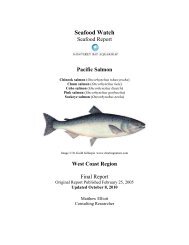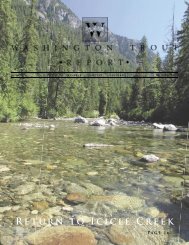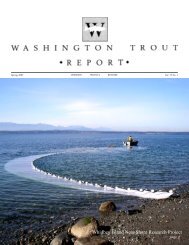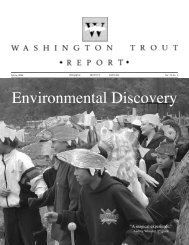Skykomish Draft Final Report - Wild Fish Conservancy
Skykomish Draft Final Report - Wild Fish Conservancy
Skykomish Draft Final Report - Wild Fish Conservancy
Create successful ePaper yourself
Turn your PDF publications into a flip-book with our unique Google optimized e-Paper software.
partitioned into upper, middle and lower thirds (Fig. 8). The latter divisions were approximated<br />
in the field by consulting aerial photographs. The area of channel edge habitat surveyed within a<br />
unit (A E ) was taken as the sum of the left-bank and right-bank subareas. Habitat unit interface<br />
area (A I ) was calculated as the lower one-third of a given unit’s survey area plus the upper onethird<br />
of the adjacent downstream unit’s survey area. Relative densities (count m -2 ) then were<br />
calculated for (i) upper, middle and lower survey areas within units by dividing corresponding<br />
fish counts by one-third of the total unit survey area; (ii) edge habitat areas within units by<br />
dividing the sum of left- and right-bank fish counts by A E (i.e. two-thirds of the total unit survey<br />
area); and (iii) habitat unit interface areas using fish counts within A I . This sampling approach<br />
allowed testing of the hypothesis that relative fish density in habitat unit subareas with relatively<br />
great physical heterogeneity (channel edge and habitat unit interface) exceeds that in more<br />
homogeneous habitats (channel center and middle) (cf. Fig. 8).<br />
For both mainstem and side channel survey areas, fish densities were calculated individually for<br />
juveniles and adults of each species observed, and for five species categories: (1) all fish species;<br />
(2) all salmonids (juvenile and adults); (3) adult salmonids; (4) juvenile salmonids; and (5) ESAlisted<br />
salmonids (Chinook salmon and bull trout, adults and juveniles). For salmonid categories<br />
2–4, mountain whitefish (Prosopium williamsoni) were excluded on the basis of the species’<br />
relatively high abundance and unthreatened status (Snohomish River Basin Salmon Recovery<br />
Forum, 2005).<br />
After an initial reconnaissance snorkel of the mainstem in late July 2004, a baseline of fish use<br />
data for summer 2004 was obtained over the course of five days (early August to early<br />
September) by snorkeling every mapped mainstem habitat unit between rm 34.5 and rm 43.3<br />
(units 1–74 consecutively; Figs 2–6) as well as the majority of mapped units within side channel<br />
networks SCB (22 units) and SCC (30 units) (Tables 1, 3). In the subsequent fall 2004 survey,<br />
mainstem habitat units were sampled by a stratified (proportional allocation) subsampling<br />
protocol (EPA, 2002). Specifically, habitat units of different types were selected randomly for<br />
survey in proportion to the frequency of their occurrence within two contiguous segments of the<br />
study reach with distinct geomorphological profiles (cf. Appendix X): “Big Eddy” in Gold Bar to<br />
Startup and Startup to the mouth of the Sultan River (Table 2). The mainstem was subsampled<br />
using this protocol on a single day in fall 2004 (mid November). Selected units in side channel<br />
network SCC were surveyed in winter 2004 (late December) to allow seasonal comparisons with<br />
summer fish use data from this network. Preliminary observations on diel variation in fish<br />
distribution and relative abundance were also made during this winter survey (cf. Table 1). WT<br />
crews attempted to snorkel side channel network SCD and the adjacent mainstem reach (i.e.<br />
below the mouth of the Sultan River; <strong>Skykomish</strong> rm 33–34.5) in December 2004 but extremely<br />
poor visibility in both areas precluded the collection of fish use data. Snorkel sites and habitat<br />
unit sample sizes for all 2004 side channel surveys are listed in Table 3.<br />
Spawning Surveys<br />
Washington Trout coordinated with Washington Department of <strong>Fish</strong> and <strong>Wild</strong>life personnel to<br />
identify the range of dates that typically encompasses the spawning runs of Chinook, chum and<br />
coho salmon in the <strong>Skykomish</strong> River braided reach. On four days within this range during fall<br />
2004 (between September and December; Table 1), WT field crews conducted surveys<br />
throughout the mainstem channel and side channel networks SCA, SCB, SCC and SCD (rm 33–<br />
43.3) to record evidence of salmon spawning activity. Surveys were performed by boat and on<br />
3






